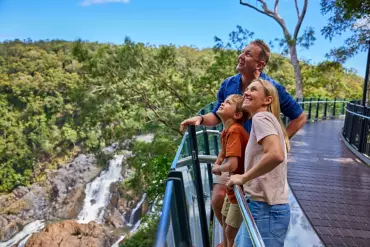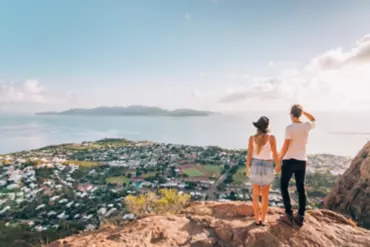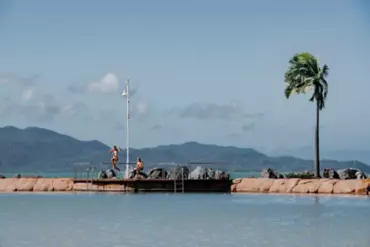How to take amazing aerial photography shots of the Great Barrier Reef
How-to
By Laura Walls
In an era where most travellers carry a top-of-the-range digital camera (commonly known as a smartphone) with them everywhere they go, more and more tourists are levelling up their travel photography skills. But capturing the breathtaking sight of the Great Barrier Reef from above is a task that even the professionals find challenging. Learn how to take spectacular aerial photography of the Great Barrier Reef with this practical guide, featuring expert advice from aerial photography specialist, Joshua Smith.
But first: what makes aerial shots of the Great Barrier Reef so difficult?

If you’re lucky enough to get to fly over this 500,000 year old natural wonder, you’ll most likely be in a small charter plane and travelling at around 200km per hour. At speeds like this, capturing the perfect shot is far from straightforward. Water complicates things even further, as does having to take your shots through glass or perspex. Fortunately, as Joshua explains, there are a few tricks of the trade which can make your amateur pics look gallery-worthy.
Here are his five top tips for capturing the beauty of the Great Barrier Reef from above:
1. Learn how to shoot through perspex

There are plenty of challenges when it comes to shooting over water. It’s a huge juggling act: cloud cover, water clarity, wind, tides, the angle of the sun and even the position of the aircraft all have to be just right.
The other thing to consider on charter aircraft is that you’ll most likely have to shoot through perspex windows. That can mean ‘in cabin’ reflections may appear in your shots.
Joshua says: “Try using a lens hood to reduce in-cabin reflections and choose dark clothing that won’t reflect the light. Perspex can scratch easily so be mindful not to push your camera onto the window!”
2. Be prepared to shoot at high speed

Imagine being 12,000 feet above sea level, gazing down at glassy azure seas and brightly coloured coral formations as minke whales and giant turtles swim far beneath you. You see the perfect shot. Then you spend the next few minutes fiddling unsuccessfully with your camera settings.
The moral of the story is: make sure you bring a good camera and get your settings ready as soon as you leave the airstrip. Remember, in a fixed-wing aircraft you’re travelling at incredible speeds and won’t have much time for the camera to lock onto your subject.
Joshua says: “For fast, accurate focusing, choose a decent digital SLR camera. They’re built with incredible focusing systems that allow for multiple focus points, making them perfect for aerial photography.”
Slower shutter speeds will result in blurry shots so make sure you set yours to at least 1/1000th of a second – faster if you can. If your autofocus has issues focussing, find a part of the reef structure to aim at and switch to manual focus instead.
Joshua adds: “Examine the flight path before you go and let the pilot know you plan to take some aerial shots. Work out where the aircraft will be in relation to the position of the sun so that you can decide where to sit for the best photo opportunities.”
(Another travel photography scenario which requires high shutter speeds is waterfall photography – find out how to take a killer waterfall shot with this guide.
3. Reduce glare and reflections with a polarising filter

Queensland has more than its fair share of sunshine which, although great for holidaymakers, can create challenges for photographers when it reflects off the water.
To enable your camera to see through the reflections, kit yourself out with a circular polarising filter for your lens. These screw-on filters help reduce that glare and let you expose the beautiful reef structure in your shots.
4. Invest in a one-size-fits-all lens

Just as you don’t want to be wasting time in the air playing with your settings, avoid having to swap out lenses by investing in a good all-rounder that allows you to capture a range of different shots.
Joshua explains: “As a professional I usually travel with a number of camera bodies in the air, but for amateurs, a wide, one-size-fits-all lens would help tell the beautiful story of the reef.
“Opt for a zoom lens such as the Canon EF 24-70mm f/4L IS, which also has the benefit of image stabilisation (handy in an aircraft). Another great lens is the Canon EF 24-105mm f/4L IS II.”
5. Think about your angles ahead of time

Where possible, Joshua recommends following his lead and photographing the reef top down – that means shooting directly over the subject: “Straight down shots of reef structure always look spectacular. Oblique aerials work nicely with some sky for reference too – in my own shots of the Great Barrier Reef I shot it slightly oblique at times to highlight the abstract elements that contribute to its unique beauty.”
Learn more about aerial photography with this how to guide on drone photography or get inspired by these incredible aerial and drone shots of iconic Queensland locations.
Need more time to get the perfect shot? Find out about ways to sleep on the reef– and squeeze in a few days’ snorkelling and diving at the same time.
Want to get closer to the Great Barrier Reef?

- Spend three days exploring the Great Barrier Reef from Cairns with this itinerary
- Go for the ultimate aerial shot by flying over this iconic reef
- Or practice your underwater photography skills while snorkelling or scuba diving
- Need more time to get the perfect shot? Sleep on the reef with this guide
You may also like


















